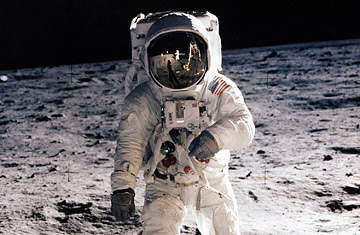
Astronaut Edwin E. Aldrin Jr. walking on the surface of the moon in 1969.
Not long ago, when most of us weren’t looking, the space age reached middle age. It’s been 39 years since the first moon landing, 43 since the first spacewalk, 47 since the first human being orbited the Earth. And this week, NASA itself — which was once the last word in moderne — turns 50. That may seem creaky, but the fact is, the space agency has been around a lot longer still.
NASA was actually founded in 1915 and at the time was known as the National Advisory Committee on Aeronautics — or NACA. Its job was to keep the nation abreast of the latest developments in the then-nascent technology of powered flight. NACA was established with good intentions but operated mostly as a bureaucratic backwater, a government body that couldn't hope to keep up with a rapidly evolving private industry. In 1957, however, all that changed. That was the year the U.S.S.R. launched Sputnik, the first Earth satellite — and in the process, scared the daylights out of the U.S. President Dwight Eisenhower acted quickly, dusting off NACA and renaming it NASA — for National Aeronautics and Space Administration. On October 1, 1958, the new agency officially went into business.
Hoping for a fast start, NASA's bosses didn't try to build labs, staff and launch sites from scratch. Rather, they went around the country cherry-picking military and academic institutions that were already doing the right kind of work and inviting them to join the new group. They went to Pasadena, where the California Institute of Technology operated its little-known Jet Propulsion Laboratory (JPL), and extended an invitation there. They made the same offer up the coast at Moffett Field, Calif., where the military operated its Ames Research Center, and also gathered up the government's missile test range at Cape Canaveral, Fla. and the Huntsville Arsenal in Alabama.
It was a lean and efficient operation for what had the potential to become a very big agency. But there was a very expensive exception to the business plan. Once NASA actually began flying human beings in space, it would need a place from which to run those missions. Cape Canaveral was the sensible site; no reason not to operate your missions from the same place you launch them. Vice President Lyndon Johnson, however, didn’t see things that way. If federal space goodies were going to be handed out, he wanted his native Texas to get its share. And as de facto head of the nation's space effort as well as the former Democratic leader of the Senate, he had the clout and friends to make that happen.
For that reason, the Manned Spacecraft Center — better known to the public as Mission Control and now formally renamed the Johnson Space Center — was built in Houston. The port city quickly became a space city, bringing in lots of people, jobs and notoriety. Ultimately, Houstonians would live to see the name of their town become the first word in two of the most evocative quotes of the space age: "Houston, Tranquillity Base here, the Eagle has landed," and "Houston, we've had a problem."
Since NASA's founding, its various shops have done a remarkably good job of sticking to their assignments. JPL handles most of the unmanned missions. Ames takes on what JPL can't, and often competitively bids against its downcoast colleagues. Huntsville focuses on rockets and propulsion systems. Canaveral still launches and Houston still takes over the moment the engine bells clear the tower. The Goddard Space Flight Center in Beltsville, Md., studies space science, investigating the chemistry and physics of the Earth, the solar system and the universe, most notably with the aid of the Hubble Space Telescope.
In the last few years, NASA had seemed safe from significant budget cuts, as the agency is preparing to mothball its space shuttles and embark on a new program to put astronauts back on the moon and later Mars. But with the markets melting down and a new administration headed to Washington in January, nothing is certain. The cosmos was here long before us and will be here long after us. Whether we continue to explore it in the brief flash of time our species has is a choice we have yet to make.
